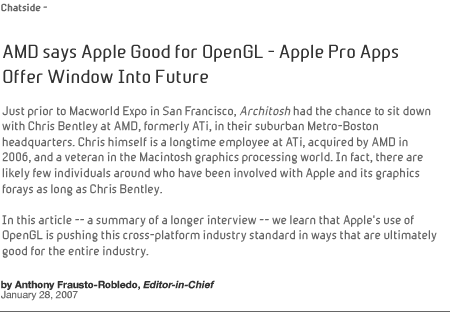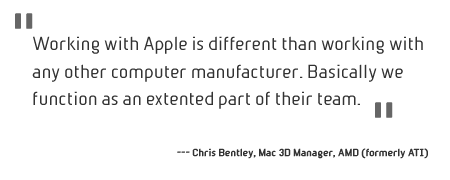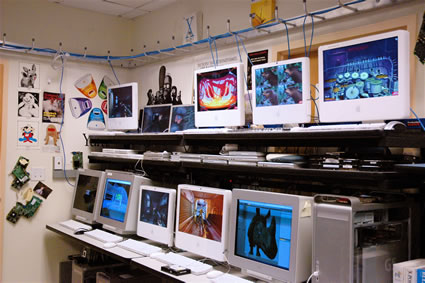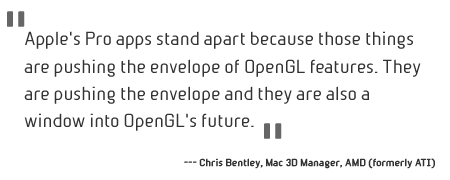|

Editor's
Note: This is the executive summary version of a more
in-depth interview here.
As
it turns out, ATI's
Mac graphics division was never
really that far from Architosh's publication studio.
In hindsight it was somewhat shameful that we didn't
discover this before. It was at SIGGRAPH
2006 Boston that Chris Bentley and I got to talking about a visit,
and it was at that show that I was first introduced
to the latest ATi Radeon X1900 series cards -- showing
off Luxology's
modo 202.
Today
of course Chris Bentley and I were meeting to discuss
AMD's business of creating bleeding edge graphics chips
for Apple. And after a quick bagel on the house
and a tour of the large ATi/AMD facility, we sat down
to discuss AMD's relationship with Apple and how Apple
was advancing OpenGL, an industry standard technology
the company's OS X user interface depends on.
Apple
and AMD - The Relationship
Before
we dug into some of the key details behind
ATi's (AMD's) new Radeon X1900 series graphics cards
for the Mac Pro and Power Mac G5, I asked Chris Bentley
about the nature of AMD's relationship with Apple.
Many in the media had been speculating that Apple's
new cozy relationship with Intel might spell some form
of trouble for AMD's future in graphics on the Mac.
However, Chris
assured me that this just isn't so.
"There
is absolutely no change in our relationship with Apple,"
said Chris. "We offer the same level of support, from
the same people, with the same engagement with Apple
and the Mac software companies. In fact, we may be
able to offer more solutions to Mac users because we
have more resources now."
AMD
obviously hopes to sell more products to Apple in the
future, their acquisition last year of Canada's ATi
gained them a legacy relationship with the storied
Mac maker. And it shows. Chris Bentley himself has
been with ATi since the mid-90's working on Mac 3D
graphics technology. And their offices are literally
filled with every vintage of Macintosh going back to
the 80's.
What
about main processors -- I asked?
Chris
could only smile at the question. Obviously there is
nothing to say about that today. But the question did
bring up a very good point. Isn't there an issue there....
"We are very close to Apple. We have early access
to hardware," remarked Chris.

This
access of course means that AMD -- an Intel rival --
gets to peak at and work with Apple's secret machines
long before Steve Jobs unveils Apple's new Macs.
"Arrangements have been made with Intel to allow
the Mac 3D driver group to work on pre-release
Apple hardware," says Chris. This means that nothing
about Intel's chips inside un-announced Mac machines
gets spilled over to AMD's CPU departments.
 |
| ATi
(AMD's) Mac 3D group has a lab full of several dozen late-model
Apple Macs, configured and scripted to run automated
2D/3D tests 24x7x365. Four technicians work in this
room (partial view) testing the latest driver code
on literally just about every OpenGL-based pro app
and all the games. In fact, visiting ATi (AMD) was
like walking through a museum of Mac games -- they
literally have them all (for testing!). |
Trust
is a key imperative in all relationships of this sort
with Apple. And the two companies work together very
closely. Chris says that ATi sees about 50% of their
source code and Apple sees about 80% of theirs. "There
are probably about 50 conversations a week with Apple
engineers," says Chris, "Working with Apple is different
than working with any other computer manufacturer.
Basically we function as an extended part of their
team."
Apple
and OpenGL
AMD's
relationship with Apple is very engaging for several
reasons, one of which is that Apple's entire windowing
system depends on OpenGL -- the industry standard 3D
technology behind professional CAD and 3D applications.
And ATi (AMD) is a key player in the past, present
and future of OpenGL. Any leading graphics card maker
would be.
"For
example," Chris says, "at AMD we have an entire group
dedicated to writing a really good compiler for vertex
and pixel shaders. That same compiler that is used
for the PC graphics card development is used for the
Mac cards."
Chris
said that Apple's adoption of OpenGL was a brilliant
move. By adopting an "industry standard" it made it
one step easier for graphics card makers -- and software
programmers -- to support the Macintosh market. And
when GPU cards become fully
programmable it became
even easier for companies like ATi (AMD) and Nvidia
to bring their best products to the Mac. The new Radeon
X1900 GT card is one such great product.
|
| ATi
(AMD's) new Radeon X1900 series cards for Mac Pro and
Power Mac G5 (last generation). The GT/XT cards have
an ATi "state-of-the-Art" processing engine. The ASIC
is identical on both the PC and Mac versions of the
card. To understand how PC and Mac cards are technically
different/same and why please read the full
discussion here. |
However,
as Chris tells it there are several reasons why Apple's
adoption of OpenGL has been brilliant. When the Mac
maker was developing its brand new operating system
in the late 90's they knew they needed to radically
transform the way the interface in OS X would be constructed
in code. Rather than think in traditional terms of
"bit map" imagery, Apple moved the entire
interface to a similar PostScript-Display model
-- something Steve Jobs'
other computer company, NeXT
had invented some years
earlier.
OS
X's interface became more streamlined -- and when
combined with the growing power of GPU's (graphic
processing
units) Mac OS X
leapfrogged the entire industry with its Aqua interface.
"Apple's
Mac OS X has been doing Vista-like features since version
10.1," says Chris. "Mac OS X virtualizes VRAM. Windows
XP does not. This has given Mac applications unique
advantages."

Apple's
use of OpenGL in the user-interface has been groundbreaking
and only with Vista in 2007 has Microsoft begun to
catch up. "Even though Quartz
Extreme was not present
in the first release of OS X, Apple was laying the
groundwork for it," says Chris.
While
OpenGL has been a key technology for Apple in its OS
X operating system, the company has been equally good
for OpenGL in the overall computer industry.
Chris
says that games and Pro apps have been concerned with
pushing the development of OpenGL in very different
ways from each other. When Apple based its interface
system on OpenGL it added another dimension to the
equation. "Quartz
Extreme put pressure on the OpenGL drivers to optimize
code paths that games and Pro apps had never cared
about," says Chris.
But
it is the Apple Pro apps (like Motion and Final
Cut Pro) that have really pushed the extremes of
OpenGL driver development
at
ATi. "Apple's
Pro apps stand apart because those things are pushing
the envelope of OpenGL features. They are pushing the
envelope and they are also a window into OpenGL's future."
---- Anthony Frausto-Robledo,
Editor-in-Chief.
the
full in-depth interview: |
1 | 2 |
3 | 4 |
|






![]()
![]()